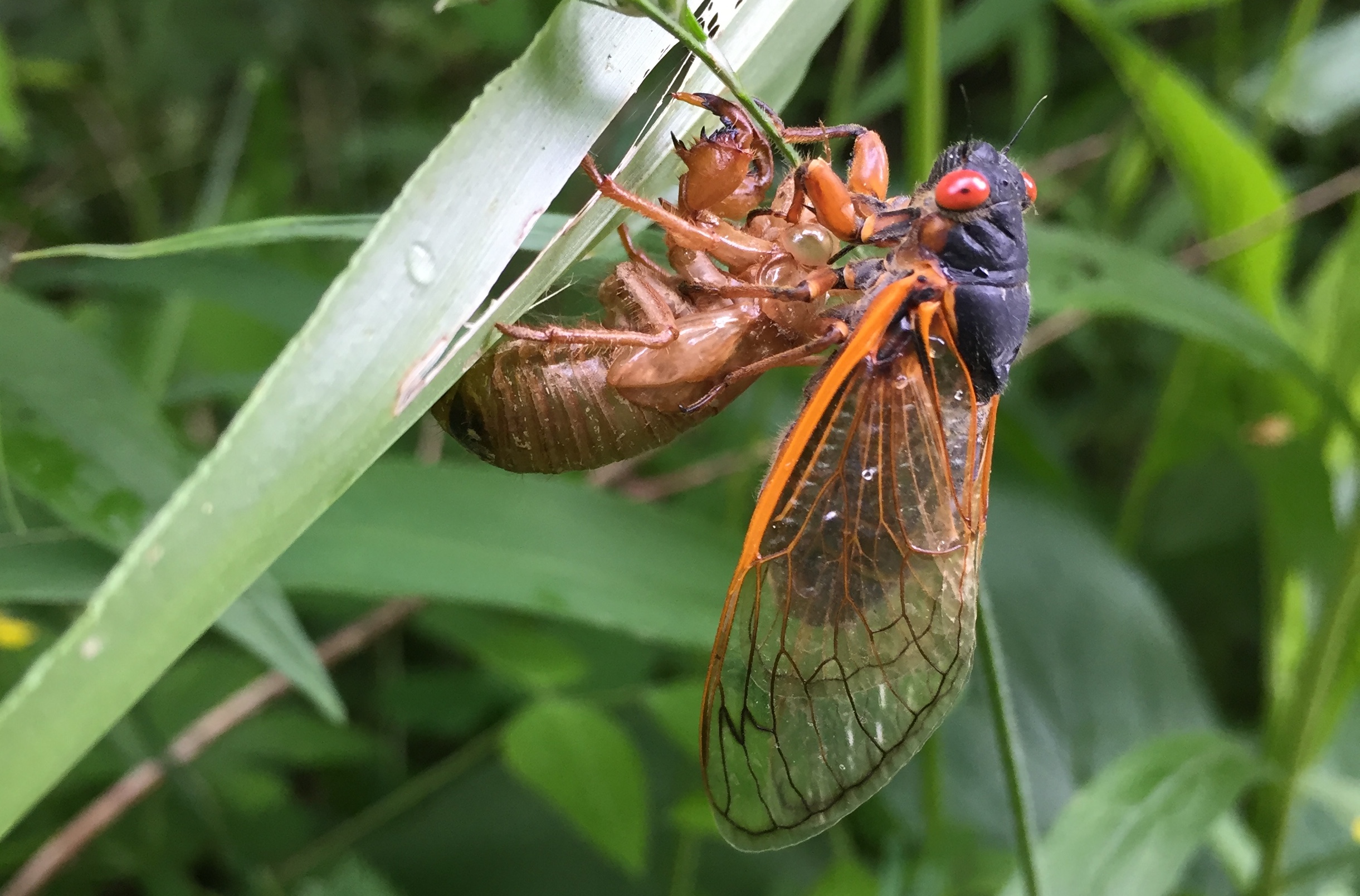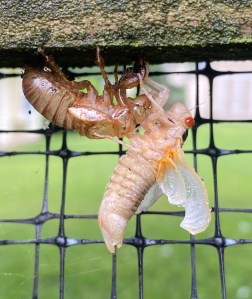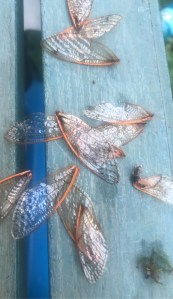A Rare Double Brood Emergence Of Cicadas Has Begun
Two cicada broods on 13- and 17-year cycles coincide this spring, meaning trillions of buzzing insects across the South and Midwest.

A male Brood VIII cicada hangs on an empty nymph skin at the Powdermill Nature Center in Rector, Pennsylvania, in June 2019. Credit: Chris Simon
It has begun. Legions of cheese-puff-sized insects have started to climb out of the dirt after spending more than a decade underground sucking sap from tree roots. Over the next month and a half, their numbers will continue to grow across the South and then the Midwest in what will become an emergence of trillions of periodical cicadas.
Dr. Jessica Ware, an entomologist at the American Museum of Natural History, finds the insects graceful. “They have these beautiful red eyes and lace-like wings,” she says.
This small sliver of their life cycle that’s visible to us, when males and females get their sole opportunity to mate, is a raucous and unforgettable affair. There can be nearly 30 cicadas per square foot. Such high densities are likely a survival strategy since cicadas that come aboveground in off-years would find themselves easy, edible targets. “There’s safety in numbers,” Ware explains. During a mass emergence, “you hopefully have made your predators full with your siblings or distant relatives and you yourself live to pass your genes on to the next generation.” (Ware says that those who feel squeamish about the coming “cicada-geddon” can reassure themselves with the fact that squirrels, chipmunks, birds and other animals will be treated to a rare, protein-rich bounty—and their numbers will grow as a result.)

There will be no doubt once the cicadas have emerged in a particular place because they produce an ear-splitting wall of sound. “They are so loud,” says Dr. Susan Gershman, an evolutionary biologist at the Ohio State University, “that you can hear them inside your house with all the windows closed.” These are the males vibrating a special pair of abdominal membranes in an attempt to woo a female to mate. A female flies to a spot near multiple males “and responds to one of the songs by making a wing flick (snap sound) in exactly the right place in the song,” says Dr. Chris Simon, an evolutionary biologist at the University of Connecticut. The male then approaches the female and changes his song. “If the female does not fly away,” Simon says, “he climbs on top and changes his song again. And then mates with the female.”
Females lay their eggs in the trees. Once the juvenile nymphs hatch six weeks later, they drop to the soil below and crawl and dig until they find a root to feed on. This is where they stay for years, “just eating and defecating,” Ware says, molting four times. Ground temperature is the signal that triggers the day of emergence either 13 or 17 years later. Once it stabilizes at 64 F about 8 inches underground, “that’s when they’ll start to come out over a period of about four or five nights,” Simon says. Aboveground, cicadas molt for a fifth and final time, shedding their skin and transforming into adults, now ready to begin the cycle again.
A “brood” refers to a population of periodical cicadas that are on the same life cycle and emerge on the same years. There are 15 broods in the US, and this year, two of them will co-emerge. They won’t overlap geographically but they’ll get close in north-central Illinois. There’s Brood XIX, the largest of all periodical cicada broods, which comprises four species and is on a 13-year cycle. And there’s Brood XIII, which consists of three species and, somewhat confusingly based on its Roman numeral designation, is on a 17-year cycle.
In the map above, positive (presence) records of Brood XIII from previous years are represented by upwards facing cicadas, and negative (absence) records of the brood are represented by blue crosses. Positive (presence) records of Brood XIX are represented by downwards facing cicadas, and negative (absence) records of the brood are represented by red crosses. Courtesy of University of Connecticut.
The length of time it takes for a cicada to develop and pass through all five of its stages, or instars, is based on temperature. “If it’s warmer, they develop faster,” Simon says, “because they have more time to feed.” This means that cicadas within a brood that have experienced consistently warmer temperatures underground can emerge early—often four years earlier than they otherwise might. For instance, a portion of the 17-year Brood XIII cicadas emerging this year already emerged in 2020 (coinciding with the 17-year Brood IX cicadas). “This early emergence has been recorded by scientists every generation since the late 1960s,” Simon says, “and the number of individual cicadas that have participated has been growing larger. We hypothesize that the large number of early emergers is due to climate warming.”

Ware says that if you have the chance to witness the cicada mega-emergence, you need to treat yourself to the “dramatic” and “wild” spectacle. There are two apps that allow citizen scientists to submit cicada locations—Cicada Safari and iNaturalist. Tracking the cicadas is important “because we know that some broods are threatened, some populations are decreasing,” Ware says. A lot has changed in the last 13 or 17 years. “Parking lots have been built, trees have been cut down … And so having good records is really helpful for science.”
In addition, birds don’t tend to eat cicada wings, and that leads to heaps of discarded translucent wings drifting to the ground. Collect these and apply a bit of resin, “and you can make earrings and jewelry out of them,” Ware says.
Or don’t do any of that, and just head outside to revel in the emergence. Let your ears fill with the cicadas’ cacophonous calls, look for them dotting the branches of your favorite trees, and give in to the thought that this is the moment their little bodies have been preparing for—one that’s been years in the making.
Ari Daniel is an independent science reporter who contributes regularly to National Public Radio, among other outlets. Over the years, he has reported across six continents on science topics ranging from astronomy to zooxanthellae.